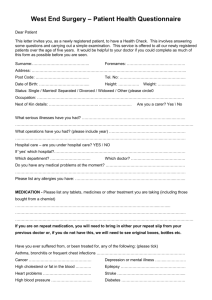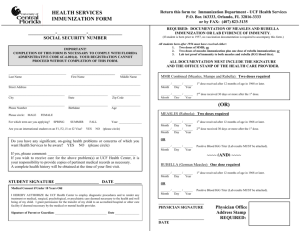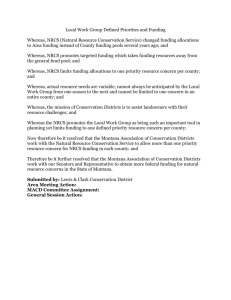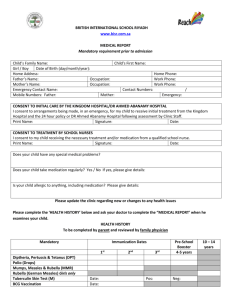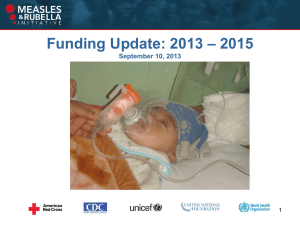Nepal Red Cross Society At a glance Key Program and services
advertisement
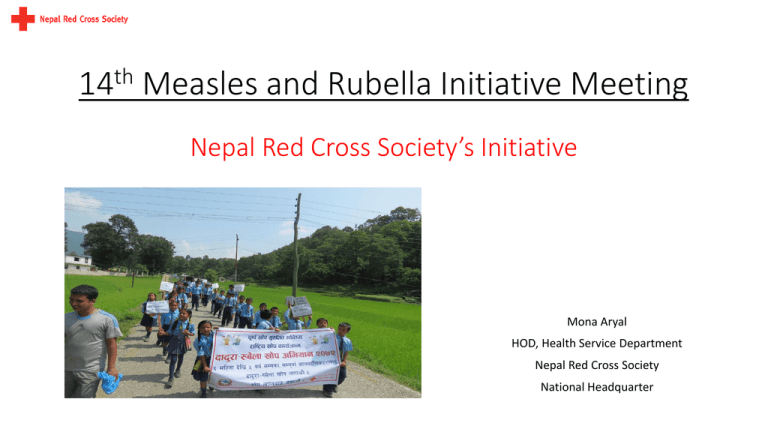
14th Measles and Rubella Initiative Meeting Nepal Red Cross Society’s Initiative Mona Aryal HOD, Health Service Department Nepal Red Cross Society National Headquarter Nepal Red Cross Society At a glance The largest humanitarian organizational with its network in all the 75 districts of Nepal with its million plus members, 90,000 volunteers and hundreds of staff. Vision: to provide immediate relief to human suffering and reduce vulnerability, under the Fundamental Principles of the Red Cross, Mission: relieve human suffering and to reduce vulnerability Key Program and services Disaster Management Water Sanitation and Hygiene Promotion (WASH) Program First Aid National Blood Transfusion Service Community Resilience Program(CPR) Health Sector Partner and development(HV and Communication) Gender and Inclusion Nepal Blood Transfusion Service Eye Hospital and Community Eye Care Centers Community Eye Care and Health Promotion Program Emergency Transportation (Ambulance Service) Organizational Development Junior and Youth Activities PMER Capacity and Enhancement Program Finance Development and Resource Mobilization Capacity Building in Emergency Health Maternal and Child Health Disease Burden Year Total no. of reported suspected measles cases Number of suspected measles outbreak investigated Number (%) of outbreak confirmed as measles outbreaks Number (%) of outbreak confirmed as rubella cases Number(%) of outbreak confirmed as mixed measles and rubella outbreaks 2003 13,344 67** 41(61) ** *** 2004 12,047 197 138(70) 13(7) 11(6) 2005 2,023 46 1(2) 36(78) 2(4) 2006 2,838 31 2(6.5) 24(77) 1(3) 2007 1,415 21+ 3(14) 11(52) 1(5) 2008 2,089 39 6(15) 27(69) 1(2.5) 2009 4,340 66 2(3) 57(89) - 2010 2,550 33 7(21) 19(58) 2(6) 2011 734 64 22(35) 31(49) 4(6) 2012 791 68 16(24) 32(48) 7(11) 2013 335 3 0(0) - - 2014 353 2 0(0) - - Source: JRF WHO-UNICEF/WHO-IPD, HMIS/DoHS/MoHP,**Outbreak investigation and laboratory testing started in March 2003;***Lab-confirmed for rubella specific IgM did not started until January 2004;”+* Samples QNS from 2 outbreaks Source: Measles surveillance, WHO-IPD, Nepal Working in partnership • NRCS headquarters coordinates with Ministry of Health and Population (MoHP), World Health Organization (WHO) and UNICEF at the national level and their sub ordinate units at the district level • NRCS district chapters works in close coordination with district public health office (DPHO)/ district health office (DHO), municipality office and district education office in the programme districts. • At community level, NRCS volunteers work closely with female community health volunteer (FCHV) of Government, Junior/Youth Red Cross Circle, Mothers Group, Teacher Sponsors, Community Leaders Immunization Campaigns Past Campaigns • Nepal Red Cross Social Mobilization for Measles/Polio/Integrated Campaign in 2008 in 17 districts (1258 volunteers mobilized) • Social Mobilization for Measles Campaign in 2009 in 11 districts (over 700 volunteers mobilized) • Social Mobilization for National Immunization Day in 2011 in 14 districts (595 volunteers mobilized) • Measles Rubella Social Mobilization Campaign 2012 in 30 municipalities of 22 districts (over 1000 volunteers and supervisors oriented and mobilized) • Social Mobilization for Total Immunization 2015 in 2 districts (405 volunteers and 8 supervisors mobilized) Current Campaign • Social mobilization for Measles Rubella Campaign in 14 most earthquake affected districts of Nepal, 2015 (435 volunteers mobilized) Immunization Campaigns Role of NRCS in the campaigns • As an auxiliary to government NRCS took part in in the campaigns through social mobilization activities. • Activities such as door to door visits, mass awareness rallies, distribution of IEC materials, display of banners with campaign messages at strategic locations Future Campaigns • NRCS is planning to support Ministry of Health and Population in achieving country targets of Measles Elimination and Rubella/Congenital Rubella Syndrome(CRS) control in Nepal (Strategy 2015-2019) • Discussions with various Partner National Societies to support NRCS program plan Routine Immunization • Besides the involvement in program activities during the implementation period, NRCS volunteers support Female Community Health Volunteers and District Public Health Office to disseminate messages on immunization/schedule/venue regularly. • NRCS Junior Circle volunteers also actively participate (as volunteers) in various immunization campaigns routinely. Other activities to support measles and rubella • NRCS shows active presence in the immunization working group meetings at the Central Level • At the district level, NRCS is also a member of District Immunization Service Committee • Discussions with various Partner National Societies to support NRCS program plan in achieving country targets of Measles Elimination and Rubella/Congenital Rubella Syndrome(CRS) control in Nepal (Strategy 2015-2019) • Immunization is one of the key component in NRCS health strategy and plan Key Challenges • Differences in capacity of District Health System in various districts(leadership, administration, stakeholders presence and involvement in the immunization program) • Differences in capacity of NRCS district Chapters and Sub Chapters • Geographical constraints • Internal migration • Hard to reach/vulnerable population: rural and urban • Funds • Recurring disaster/Current disaster (earthquake) Key learning Key learning points • NRCS can play a supportive role in the coordination at both district and community level • Participation of Junior/Youth Red Cross volunteers can support the social mobilization program • Dissemination of message in local language is more effective in reaching the target population • It is important to involve the community, local stakeholders as well in the program planning process • Involvement of FCHVs and women/mother’s group in the local community show greater impacts Thank You

